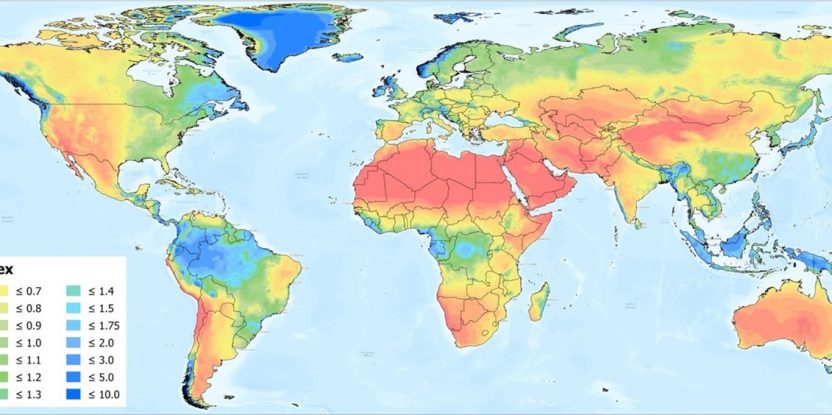The index is based upon a fully parameterized geospatial implementation of the Penman-Monteith Equation, a standard methodology widely used globally.
The peer-reviewed article describing the database, which has a global coverage at a very high spatial resolution of approximately 1 km2, has recently been published in Nature Scientific Data. The authors provide a technical evaluation of the dataset using real-world weather station data.
The database has already shown itself to be a valuable global public good. Earlier versions of the Global Aridity Index and Potential Evapotranspiration Database have been available since 2009, downloaded nearly 50,000 times and applied across a wide range of disciplines. There have been nearly 1500 citations on topics ranging from agricultural and natural resource sciences through genetics and anthropology to archaeology, conflict resolution and climate change.
‘These datasets have been found useful across a wide variety of applications, particularly those related to water management and crop production and also socio-ecological and socio-economic applications addressing sustainable development and climate change. This can be particularly useful for local adaptation to global change,’ said Robert Zomer, lead author of the article and a presidential fellow of the Chinese Academy of Sciences at the Center for Mountain Futures, a joint venture of the Center for International Forestry Research and World Agroforestry (CIFOR-ICRAF) with other partners.
Jianchu Xu, a co-author of the paper, professor at the Kunming Institute of Botany and principal scientist at CIFOR-ICRAF China noted the global importance of the Index.
‘The high resolution of the Global Aridity Index provides great potential to map climatic and environmental risks,’ he said. ‘Humans and all forms of life need water, therefore, the Index is critically important in planning for both conservation and development.’
The topics of papers citing the Database indicate its applicability to a huge range of disciplines and issues: droughts, wildfires, human migration, pastoralism, desertification, wildlife and restoration ecology, child mortality, and epidemiological and other human and livestock health research, such as the effect of malaria control and mapping the zoonotic niche of Ebola virus disease in Africa.
‘Not only is the data improved but publishing the source code used to develop this analysis makes it available for local and specific applications using local data, improved or updated climate data,’ said Antonio Trabucco of the Centro Euro-Mediterraneo sui Cambiamenti Climatici. ‘We think that this database and its source code provide robust tools that can help to meet the challenges of a rapidly changing global aridity environment.’
We want you to share Forests News content, which is licensed under Creative Commons Attribution-NonCommercial-ShareAlike 4.0 International (CC BY-NC-SA 4.0). This means you are free to redistribute our material for non-commercial purposes. All we ask is that you give Forests News appropriate credit and link to the original Forests News content, indicate if changes were made, and distribute your contributions under the same Creative Commons license. You must notify Forests News if you repost, reprint or reuse our materials by contacting forestsnews@cifor-icraf.org.
